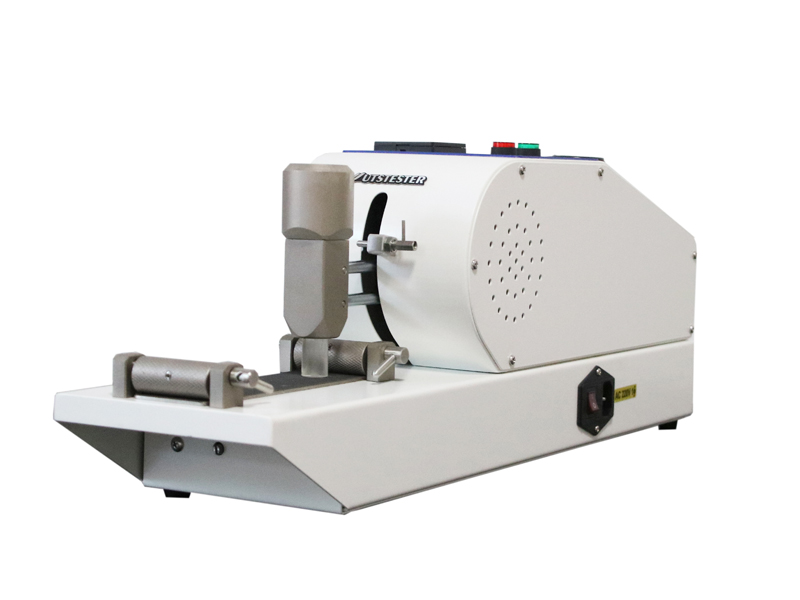 +86 152 6060 5085
+86 152 6060 5085
 +86 152 6060 5085
+86 152 6060 5085
Blog
Catalog
Latest Blog
One. Rubbing color fastness test principle:
Under a certain pressure, the surface of the fabric is rubbed repeatedly with dry cotton white cloth or wet cotton white cloth, and then the color of the cotton cloth is rated.
Dry friction color fastness is a required test item in GB18401, and must be higher than or equal to level 3 to pass GB18401, is a very important test item.
Two, the four standards of The United States, Europe and Japan comparison:
There are three types of instruments for testing rubbing colour fastness:
1, a type of linear reciprocating friction color fastness tester, is currently the most widely used test instrument, GB/T3920, ISO 105 X12, AATCC 8, JIS L 0849 I all use this method, and are 9N pressure, 100-104mm range, speed one reciprocating, 10 reciprocating. Manual or electric. (GB and ISO grinding warp and weft direction, American standard oblique Angle, Japanese standard according to the customer's instructions can be warp and weft two-way or only measured warp direction).
2, the second type is rotary friction color fastness instrument, GB/T29865A, ISO 105 X16, AATCC 116 using this method, this method is suitable for dark small area printing fabric. This method is used to test dark plain fabrics, and the results are slightly better than those obtained by linear reciprocating tests.
3, the third type is arc surface friction color fastness tester, the most commonly used is JIS L 0849 LL type, 2N pressure, 100mm range, 30 reciprocating, 100 reciprocating.
There is not much difference in the friction color fastness between The United States and Europe. The biggest difference is the Japanese standard, which is the most stringent. Compared with other test methods, the dark color test results obtained by JISL0849II may be half or even one level worse. At present, many Japanese customers use this method as a testing standard for rubbing color fastness, such as Uniqlo and Muji.
Three. Inference and Discussion:
There are two key factors that affect the rubbing colour fastness. One is how well the dye binds to the fiber, that is, how easily it can be transferred from the fabric to the rubbing white cloth by rubbing and water (wet rubbing). The other is the firmness of the fiber itself in the yarn, whether there are hairiness or fiber crumbs that are easy to fall off, which will stick to the test white cloth through friction. As shown in the image below, the color patches of the white cloth observed in the friction test at 250 magnification can be seen as distinct black fiber crumbs.

From this, several inferences can be drawn:
1. If the color fastness of dark products is not good, their rubbing fastness is usually not good, which can be improved by strengthening the soaping or setting the reduction cleaning method in the process. Soaping fastness can be an indicator of whether there is room for improvement in rubbing fastness.
2. For products with good soap fastness, the main reason for poor rubbing color fastness is not that there is no fixed dye stain test white cloth, but that the fibers and dark fiber crumbs on the fabric are easy to fall and stain the test white cloth. This is the main reason why the wet rubbing fastness of such products as ground cloth, open fiber cloth and enzyme washing cloth is worse than that of cloth without such treatment. Even if the soaping fastness of such products is very good, the rubbing fastness is not good.
3. Because there is a layer of fluff on the surface of such fabrics as ground wool and open fiber, the surface area increases, so it is difficult to get dark color, usually prone to oversaturation of dye, there are a lot of unfixed floating color on the fabric, once oversaturated, the color fastness to washing and rubbing will be poor, and it is difficult to completely improve by the method of soaping. This kind of product should choose to lift the better dye.
4. The principle of wet rubbing fastness enhancer is surface film formation.
5, adding soft will reduce the rubbing color fastness, the reason is that the softener can extract the dye, will extract the dye to the surface, and then stain the white cloth. Silicone oil softeners have a stronger extraction effect than film softeners, resulting in a greater loss of rubbing fastness.
6. Staple fiber fabrics with the same yarn count density will have a slightly better rubbing fastness with the closer yarn spinning method. For example, compact spinning will have a better air flow spinning. Done to make the fiber strength and toughness damage chemical treatment, will likely make the fiber brittle damage, it is easier to produce some fiber crumbs in the friction test white cloth, so as to reduce the friction color fastness.
All need to be tested to determine whether the cloth is qualified. To learn more about Rubbing colour fastness tester, click here.
Email: hello@utstesters.com
Direct: + 86 152 6060 5085
Tel: +86-596-7686689
Web: www.utstesters.com